
Conservation Letters
Scope & Guideline
Advancing Conservation Science for a Sustainable Future
Introduction
Aims and Scopes
- Biodiversity Conservation Strategies:
Research focusing on diverse strategies for conserving biodiversity, including protected areas, habitat restoration, and species management. - Human-Wildlife Interactions:
Studies examining the dynamics between human activities and wildlife, including hunting, habitat encroachment, and community-based conservation efforts. - Policy and Governance:
Analysis of conservation policies, governance frameworks, and their effectiveness in achieving biodiversity targets and addressing socio-political challenges. - Ecological Monitoring and Assessment:
Methodological advancements in monitoring biodiversity and ecosystem health, including the use of technology and citizen science. - Climate Change and Conservation:
Research addressing the impacts of climate change on biodiversity and exploring adaptive management strategies to mitigate these effects. - Cultural and Social Dimensions of Conservation:
Exploration of how cultural values, indigenous knowledge, and social equity influence conservation outcomes and stakeholder engagement.
Trending and Emerging
- Integration of Indigenous Knowledge:
A growing trend towards incorporating indigenous perspectives and traditional ecological knowledge into conservation strategies, recognizing their value in sustainable management. - Citizen Science and Community Engagement:
Increased focus on citizen science as a tool for data collection and community involvement in conservation efforts, enhancing public awareness and participation. - Interdisciplinary Approaches to Conservation:
Emerging research that bridges disciplines such as economics, social sciences, and conservation biology, highlighting the complexity of conservation challenges. - Impact of Climate Change on Conservation:
Rising emphasis on understanding how climate change affects biodiversity and ecosystems, driving the need for adaptive management practices. - Equity and Justice in Conservation:
A significant increase in discussions around equity, social justice, and the ethical implications of conservation actions, reflecting a broader movement towards inclusive practices.
Declining or Waning
- Invasive Species Management:
While still relevant, the focus on invasive species management has decreased, possibly due to shifting attention towards broader ecological interactions and conservation strategies. - Single-Species Conservation:
Research centered solely on single-species conservation has become less common as the field increasingly recognizes the importance of ecosystem-level approaches. - Traditional Conservation Models:
There is a noticeable decline in publications advocating for conventional conservation models, with an increasing preference for innovative and integrated approaches that consider socio-ecological systems.
Similar Journals
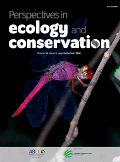
Perspectives in Ecology and Conservation
Exploring critical perspectives in ecology and environmental management.Perspectives in Ecology and Conservation, published by Elsevier Science Ltd, is a leading academic journal dedicated to advancing the fields of ecology, conservation, and environmental management. With a Q1 ranking in multiple categories, including Ecology, Management, Monitoring, Policy and Law, and Nature and Landscape Conservation, this journal boasts an impressive standing among its peers, making it essential reading for researchers and professionals. Since its inception in 2017 and running through 2024, it aims to provide innovative perspectives and critical analyses that enhance our understanding and practices in conservation science. The journal is accessible through open access options, facilitating broader dissemination of knowledge. Its commitment to addressing contemporary ecological challenges reinforces its importance in the academic community, promoting sustainable practices and informed policy-making in the face of urgent environmental issues.
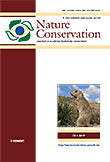
Nature Conservation-Bulgaria
Fostering collaboration in the pursuit of environmental excellence.Nature Conservation-Bulgaria is a distinguished peer-reviewed journal published by PENSOFT PUBLISHERS, dedicated to advancing the field of conservation through a comprehensive exploration of ecological and environmental issues. Since its inception in 2012, this Open Access journal has cemented its position as an essential resource for researchers, professionals, and students interested in the complex dynamics of ecosystems and biodiversity conservation. With an impressive Q2 ranking in both the Ecology, Evolution, Behavior and Systematics and Nature and Landscape Conservation categories, the journal showcases significant contributions to ecological scholarship, reflecting its commitment to vibrant and impactful research. The journal's coverage extends from 2012 to 2024, and it is indexed in Scopus, where it ranks in the 63rd percentile for key areas within Agricultural and Biological Sciences. With its base in Bulgaria, the journal also aims to highlight regional conservation efforts while maintaining global relevance, making it an indispensable platform for disseminating vital knowledge and fostering collaboration across the scientific community.

PACIFIC CONSERVATION BIOLOGY
Empowering conservation through rigorous research and collaboration.PACIFIC CONSERVATION BIOLOGY is an esteemed academic journal published by CSIRO PUBLISHING, dedicated to advancing research in the fields of ecology and nature conservation. With a strong focus on the unique challenges and biodiversity of the Pacific region, this journal serves as a crucial platform for researchers, conservationists, and students alike to disseminate high-quality, impactful findings. Operating from Australia, it has become a significant resource since its inception in 1993, navigating through nearly three decades of vital scholarly communication. Ranked in the Q2 category for both Ecology and Nature and Landscape Conservation as of 2023, PACIFIC CONSERVATION BIOLOGY maintains rigorous standards, as reflected in its successful Scopus rankings. The journal plays a pivotal role in addressing pressing ecological issues and fostering innovative conservation strategies, making it an essential reference for anyone involved in environmental science. Access options for the journal facilitate widespread distribution of knowledge, supporting the mission to promote informed decision-making in conservation practices.

ANIMAL BIODIVERSITY AND CONSERVATION
Advancing knowledge for a thriving planet.ANIMAL BIODIVERSITY AND CONSERVATION is a distinguished open-access journal dedicated to advancing the knowledge of animal biodiversity and conservation practices. Published by the esteemed MUSEU DE CIENCIES NATURALS-ZOOLOGIA in Spain, it provides a platform for researchers and professionals in the fields of Animal Science and Nature Conservation. With its ISSN of 1578-665X and E-ISSN 2014-928X, the journal has been committed to open access publication since 2001, ensuring that valuable research is easily accessible to a global audience. As of 2023, it holds an impressive Q2 ranking in both Animal Science and Zoology and Nature and Landscape Conservation, reflecting its impact and relevance in the scholarly community. The journal covers a broad scope of topics, contributing vital insights and fostering discussions that support the conservation of biodiversity. With key Scopus rankings revealing its standing among the top journals in its field, ANIMAL BIODIVERSITY AND CONSERVATION continues to be an essential resource for researchers, conservationists, and students dedicated to understanding and preserving the rich tapestry of life on our planet.
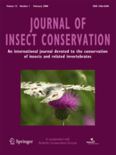
JOURNAL OF INSECT CONSERVATION
Fostering Knowledge for a World Rich in InsectsJOURNAL OF INSECT CONSERVATION, published by SPRINGER in Switzerland, is a leading peer-reviewed journal that focuses on the preservation and study of insect biodiversity and ecology. With an ISSN of 1366-638X and E-ISSN 1572-9753, this journal represents a vital resource for researchers and practitioners in the fields of Animal Science, Ecology, and Insect Science. The journal consistently ranks among the top quartiles, achieving Q1 status in Animal Science and Zoology and Q2 in other pertinent categories in 2023, according to Scopus rankings. This reflects its significant influence in the academic community, with a solid impact factor that highlights its importance in advancing the discourse on insect conservation. Though not an open access journal, it provides critical insights and innovative research findings from 1997 to 2024, making it an essential platform for those involved in the conservation of insect species and their habitats. As a scholarly resource, the JOURNAL OF INSECT CONSERVATION is dedicated to fostering knowledge dissemination and inspiring future research in pressing environmental issues.
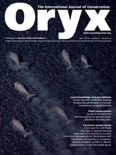
ORYX
Connecting Researchers for a Greener TomorrowORYX, published by Cambridge University Press, stands as a prestigious scholarly journal in the fields of Ecology, Evolution, and Conservation. With an ISSN of 0030-6053 and E-ISSN 1365-3008, this journal has been a critical platform for researchers and professionals since its inception in 1950. Recognized for its excellence, ORYX ranks in the Q1 quartile for both Ecology, Evolution, Behavior and Systematics and Nature and Landscape Conservation as of 2023, highlighting its influential contributions to the field. With a strong focus on disseminating innovative research and fostering collaboration among scientists, the journal covers a broad array of topics, from biodiversity and ecosystem services to conservation strategies and policy implications. As a result, ORYX provides invaluable insights that help shape the future of environmental science. Its impressive Scopus rankings place it in the top 80th percentile in its categories, further underscoring its importance and appeal among academics, professionals, and students alike.

Frontiers in Conservation Science
Fostering Collaboration for a Greener TomorrowFrontiers in Conservation Science, published by Frontiers Media SA in Switzerland, is an esteemed open-access journal dedicated to advancing research in the field of conservation science. With an E-ISSN of 2673-611X, this journal aims to facilitate the exchange of knowledge among researchers, professionals, and students by publishing high-quality, peer-reviewed articles that explore innovative solutions to contemporary conservation challenges. Since its establishment in 2020, the journal has rapidly ascended to a Q2 ranking in the Nature and Landscape Conservation category, reflecting its commitment to impactful scholarship, as evidenced by its Scopus rank of #93 out of 211 in Environmental Science and a 56th percentile ranking. By promoting open access, Frontiers in Conservation Science ensures that vital research is widely disseminated, fostering collaboration and informed decision-making in the conservation community. This journal is a crucial platform for those dedicated to understanding and preserving our planet's biodiversity and landscapes.
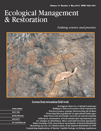
ECOLOGICAL MANAGEMENT & RESTORATION
Connecting science and practice in ecological management.Ecological Management & Restoration is a premier international journal published by Wiley, dedicated to advancing the fields of ecology, environmental management, conservation, and restoration practices. With an impact factor that positions it in the Q2 category across various ecological and management domains, this journal serves as a critical platform for researchers and professionals seeking to address contemporary issues related to ecosystem health, biodiversity, and sustainable management. Covering a wide range of topics from ecological restoration techniques to policy impacts on nature conservation, the journal caters to a diverse audience and contributes to the scientific community's understanding of environmental challenges. Importantly, the journal provides significant visibility, ranking in the top percentiles within key ecological research arenas such as Nature and Landscape Conservation, reinforcing its value for researchers aiming to influence both scientific thought and practical applications in ecology and management. The journal's commitment to disseminating high-quality research makes it an essential resource for students, researchers, and practitioners dedicated to fostering a sustainable future.
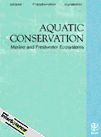
AQUATIC CONSERVATION-MARINE AND FRESHWATER ECOSYSTEMS
Advancing aquatic knowledge for a sustainable future.AQUATIC CONSERVATION-MARINE AND FRESHWATER ECOSYSTEMS, published by WILEY, is a premier international journal dedicated to advancing the understanding of aquatic ecosystems and their conservation. With an impact factor reflecting its significant influence and a distinguished position in the Q1 quartile across key categories such as Aquatic Science, Ecology, and Nature and Landscape Conservation, this journal serves as an essential resource for researchers and professionals engaged in the study and protection of marine and freshwater environments. Covering a broad array of topics, from ecosystem management to conservation strategies, the journal encourages the dissemination of innovative research and interdisciplinary perspectives. Although it is not an open-access publication, this journal is esteemed for its rigorous peer-review process, facilitating a platform where vital research influences policy and practice in the aquatic sciences. Established in 1991, AQUATIC CONSERVATION continues to be a cornerstone in the academic exploration and safeguarding of aquatic ecosystems through to its converged years of 2024 and beyond, providing a critical lens for the future of environmental sustainability.

Eco mont-Journal on Protected Mountain Areas Research
Exploring the depths of ecology in protected mountain areas.Eco mont-Journal on Protected Mountain Areas Research, published by the AUSTRIAN ACAD SCIENCES PRESS, UNIV INNSBRUCK, is a pioneering open-access journal dedicated to advancing knowledge in the fields of ecology, nature conservation, and the management of protected mountain areas. Established in 2009, this journal aims to publish innovative research, policy analyses, and management strategies that contribute to the sustainable development and conservation of mountain ecosystems. With a recognition of its importance within the environmental science community, Eco mont has been progressively indexed with Scopus ranks in various categories, reflecting its growing influence in the fields of nature and landscape conservation as well as ecology. As a vital platform for researchers, professionals, and students interested in the complexities and challenges of mountain area conservation, Eco mont provides immediate and widely accessible insights crucial for informed decision-making and policy formulation in mountainous environments.